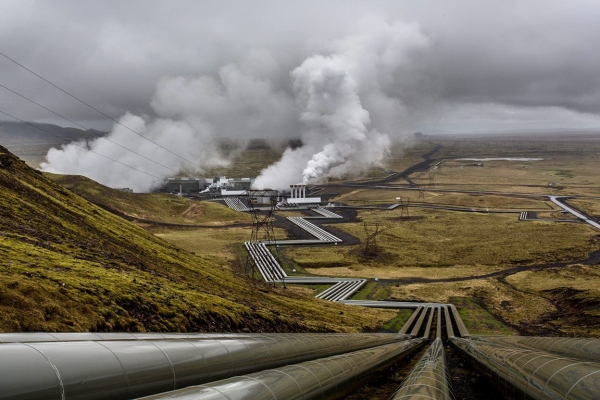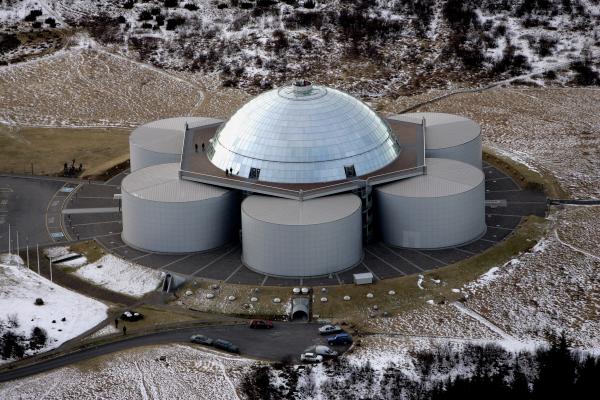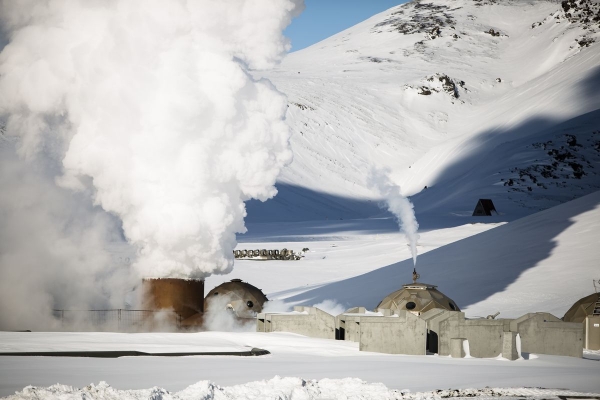In Reykjavík geothermal power is all around you! Did you know that most of the hot water consumed in Reykjavík is actually produced within the city or its suburbs? And that many of the boreholes are actually located along one of Reykjavík's busiest streets? Here is our list of nine fascinating facts about the Reykjavík hot water utility.
Read more: Reykjavík: A city powered by geothermal energy
1. Reykjavík derives its name from the geothermal activity on the peninsula

A literal translation of Reykjavík is “smoky bay” or “steamy bay.” Reykur, in Old Norse, could mean either smoke or steam, and there are numerous place names around Iceland containing different forms of the word reykur, virtually all of them a reflection of nearby geothermal activity. The smoke or steam in Reykjavík would have come from the geothermal area in Laugardalur valley, east of downtown.
2. 11% of all hot water consumed in Reykjavík comes from boreholes within the city proper
The geothermal areas within the city itself are still an important source of power for the inhabitants of the city. In 1930, the first houses were connected to the boreholes in Laugardalur valley. Despite the dramatic growth of the city and its need for hot water, 10 wells in this geothermal area still supply the capital and the surrounding suburbs with 8% of its needs. A second geothermal area within the city proper, in the valley of Elliðaár, supplies a further 3%.
Read more: Geothermal power generates higher living standards, lower heating costs and less pollution
3. If you know what to look for you can also spot the boreholes

Despite it having been one of the largest public works in Iceland, the Reykjavík central heating utility is not particularly visible. With the exception of the pipelines carrying water from Reykir or Nesjavellir, the distribution system is, of course, underground. This leaves the storage tanks as the most visible part of the utility. But if you know what you are looking for, you can also spot several boreholes. The easiest place to spot boreholes is around the intersection where Laugavegur changes names to Suðurlandsbraut, near Hotel Nordica and Grand Hotel. A total of ten boreholes are scattered around this area, each one located under strange-looking stainless steel structures, some of which have steam rising from exhaust vents.
4. More than half of the hot water consumed in the capital region is produced in Reykjavík and its suburbs
One of the first attempts to use geothermal hot water to heat residential houses in Iceland occurred in the suburban municipality Mosfellssveit, to the Northeast of Reykjavík. In 1908, a local farmer diverted water from a nearby spring to heat his farm, Suður Reykir. In 1933, drilling began in the Reykir geothermal area, and in 1939, work began on a pipeline connecting these wells to Reykjavík. In 1943, water from these wells was added to the Reykjavík system, greatly increasing its capacity. Since then, the farm Suður Reykir has been engulfed in the rapidly growing city, fed by the energy of geothermal power.
Today, these wells, and a second geothermal area in Mosfellssveit, Reykjahlíð, supply the capital region with 44% of its hot water.
Read more: NYT finds geothermal public pools key to social harmony and well-being in Iceland
5. Orkuveita Reykjavík, Reykjavík’s hot water utility, is the largest geothermal heating utility in the world

The capacity of the low-temperature geothermal fields within the city and its suburbs, in Laugarnes, the valley of Elliðaár, Reykir, and Reykjahlíð, had been reached by the 1980s. To meet the growing demands, boreholes were sunk in the Nesjavellir geothermal area in the foothills of the mountain Hengill, south of Þingvallavatn lake. Hengill is an active volcano, and the geothermal areas in its foothills are among the most powerful high-temperature fields in Iceland. With the addition of Nesjavellir, the Reykjavík Power Utility now supplies more than 70 gigalitres of hot water, with an installed capacity of 750 MWt, making it by far the largest municipal geothermal heating service, supplying 56% of the population of Iceland with hot water.
6. Reykjavík has two separate hot water systems
Due to the very different chemical makeup and corrosive properties of the water from the low-temperature fields and the heated groundwater coming from the Nesjavellir plant, water from the two systems must be kept separate. The capital region therefore has two separate hot water systems.
The system carrying water from the low-temperature areas covers the northern part of the greater Reykjavík region (including downtown Reykjavík), with the exception of several more recent suburbs, while the southern part of the capital area gets its hot water from the high-temperature fields.
7. Those huge tanks on top of Öskjuhlíð hill? They store hot water

Sitting on top of Öskjuhlið hill, south of downtown Reykjavík, is an odd-looking building: a giant glass dome sitting atop 6 large cylinders. This structure is actually 6 storage tanks, built to store hot water to meet periodic changes in demand. The tanks were originally built in 1940, at the end of the pipeline delivering geothermal water from the Reykir geothermal area. In 1991, the original tanks were updated and the glass-domed observation deck, restaurant, and shops were built atop the tanks.
8. The water smells of sulphur, because much of it is actually unfiltered geothermal water
One of the first things foreign visitors notice in Iceland is that the hot water smells like rotten eggs. The reason is very simple: water from the low-temperature fields is pumped directly into the system, which means more than half of the hot water coming from the tap is actually pure, unfiltered geothermal water, which is high in sulfur! Most geothermal heating services around Iceland similarly pump water directly from the ground to consumers.
9. … or because hydrogen sulphide gas is actually added to the water!

Only about half of the hot water in Reykjavík is pumped directly from the ground. The other half comes from the Nesjavellir high-temperature field. But water from high-temperature fields is too saturated with various minerals to be safe for consumption or suitable for delivery over long distances by pipeline.
Water from the Nesjavellir field, which supplies 45% of the hot water consumed in the capital region, is therefore used to heat fresh groundwater, which is then piped to Reykjavík consumers. The groundwater is infused with hydrogen sulphide gas to eliminate oxygen, which would corrode the pipes. Aside from protecting water pipes from rust and corrosion, this has the added bonus that this water also acquires the familiar sulphuric smell!
In Reykjavík geothermal power is all around you! Did you know that most of the hot water consumed in Reykjavík is actually produced within the city or its suburbs? And that many of the boreholes are actually located along one of Reykjavík's busiest streets? Here is our list of nine fascinating facts about the Reykjavík hot water utility.
Read more: Reykjavík: A city powered by geothermal energy
1. Reykjavík derives its name from the geothermal activity on the peninsula

A literal translation of Reykjavík is “smoky bay” or “steamy bay.” Reykur, in Old Norse, could mean either smoke or steam, and there are numerous place names around Iceland containing different forms of the word reykur, virtually all of them a reflection of nearby geothermal activity. The smoke or steam in Reykjavík would have come from the geothermal area in Laugardalur valley, east of downtown.
2. 11% of all hot water consumed in Reykjavík comes from boreholes within the city proper
The geothermal areas within the city itself are still an important source of power for the inhabitants of the city. In 1930, the first houses were connected to the boreholes in Laugardalur valley. Despite the dramatic growth of the city and its need for hot water, 10 wells in this geothermal area still supply the capital and the surrounding suburbs with 8% of its needs. A second geothermal area within the city proper, in the valley of Elliðaár, supplies a further 3%.
Read more: Geothermal power generates higher living standards, lower heating costs and less pollution
3. If you know what to look for you can also spot the boreholes

Despite it having been one of the largest public works in Iceland, the Reykjavík central heating utility is not particularly visible. With the exception of the pipelines carrying water from Reykir or Nesjavellir, the distribution system is, of course, underground. This leaves the storage tanks as the most visible part of the utility. But if you know what you are looking for, you can also spot several boreholes. The easiest place to spot boreholes is around the intersection where Laugavegur changes names to Suðurlandsbraut, near Hotel Nordica and Grand Hotel. A total of ten boreholes are scattered around this area, each one located under strange-looking stainless steel structures, some of which have steam rising from exhaust vents.
4. More than half of the hot water consumed in the capital region is produced in Reykjavík and its suburbs
One of the first attempts to use geothermal hot water to heat residential houses in Iceland occurred in the suburban municipality Mosfellssveit, to the Northeast of Reykjavík. In 1908, a local farmer diverted water from a nearby spring to heat his farm, Suður Reykir. In 1933, drilling began in the Reykir geothermal area, and in 1939, work began on a pipeline connecting these wells to Reykjavík. In 1943, water from these wells was added to the Reykjavík system, greatly increasing its capacity. Since then, the farm Suður Reykir has been engulfed in the rapidly growing city, fed by the energy of geothermal power.
Today, these wells, and a second geothermal area in Mosfellssveit, Reykjahlíð, supply the capital region with 44% of its hot water.
Read more: NYT finds geothermal public pools key to social harmony and well-being in Iceland
5. Orkuveita Reykjavík, Reykjavík’s hot water utility, is the largest geothermal heating utility in the world

The capacity of the low-temperature geothermal fields within the city and its suburbs, in Laugarnes, the valley of Elliðaár, Reykir, and Reykjahlíð, had been reached by the 1980s. To meet the growing demands, boreholes were sunk in the Nesjavellir geothermal area in the foothills of the mountain Hengill, south of Þingvallavatn lake. Hengill is an active volcano, and the geothermal areas in its foothills are among the most powerful high-temperature fields in Iceland. With the addition of Nesjavellir, the Reykjavík Power Utility now supplies more than 70 gigalitres of hot water, with an installed capacity of 750 MWt, making it by far the largest municipal geothermal heating service, supplying 56% of the population of Iceland with hot water.
6. Reykjavík has two separate hot water systems
Due to the very different chemical makeup and corrosive properties of the water from the low-temperature fields and the heated groundwater coming from the Nesjavellir plant, water from the two systems must be kept separate. The capital region therefore has two separate hot water systems.
The system carrying water from the low-temperature areas covers the northern part of the greater Reykjavík region (including downtown Reykjavík), with the exception of several more recent suburbs, while the southern part of the capital area gets its hot water from the high-temperature fields.
7. Those huge tanks on top of Öskjuhlíð hill? They store hot water

Sitting on top of Öskjuhlið hill, south of downtown Reykjavík, is an odd-looking building: a giant glass dome sitting atop 6 large cylinders. This structure is actually 6 storage tanks, built to store hot water to meet periodic changes in demand. The tanks were originally built in 1940, at the end of the pipeline delivering geothermal water from the Reykir geothermal area. In 1991, the original tanks were updated and the glass-domed observation deck, restaurant, and shops were built atop the tanks.
8. The water smells of sulphur, because much of it is actually unfiltered geothermal water
One of the first things foreign visitors notice in Iceland is that the hot water smells like rotten eggs. The reason is very simple: water from the low-temperature fields is pumped directly into the system, which means more than half of the hot water coming from the tap is actually pure, unfiltered geothermal water, which is high in sulfur! Most geothermal heating services around Iceland similarly pump water directly from the ground to consumers.
9. … or because hydrogen sulphide gas is actually added to the water!

Only about half of the hot water in Reykjavík is pumped directly from the ground. The other half comes from the Nesjavellir high-temperature field. But water from high-temperature fields is too saturated with various minerals to be safe for consumption or suitable for delivery over long distances by pipeline.
Water from the Nesjavellir field, which supplies 45% of the hot water consumed in the capital region, is therefore used to heat fresh groundwater, which is then piped to Reykjavík consumers. The groundwater is infused with hydrogen sulphide gas to eliminate oxygen, which would corrode the pipes. Aside from protecting water pipes from rust and corrosion, this has the added bonus that this water also acquires the familiar sulphuric smell!






